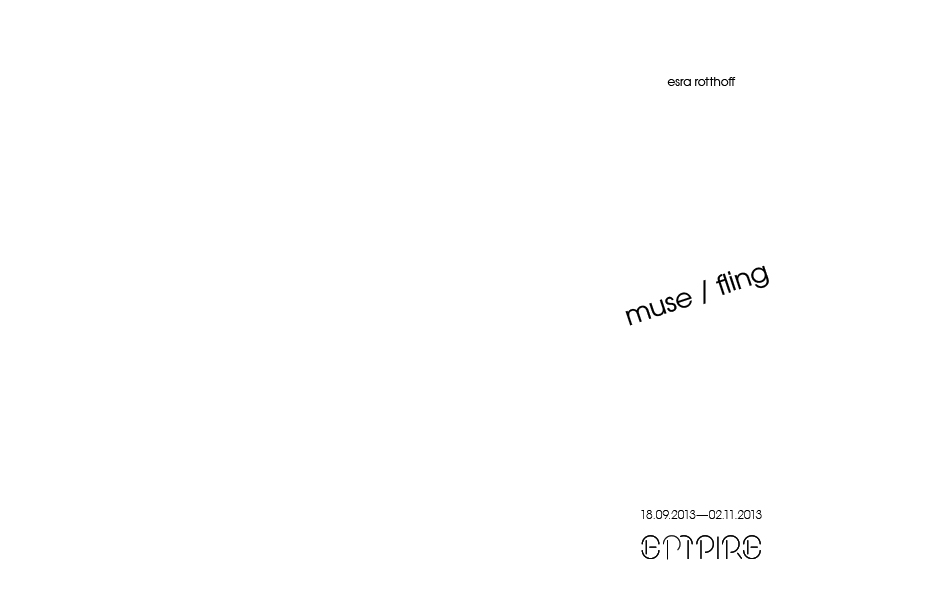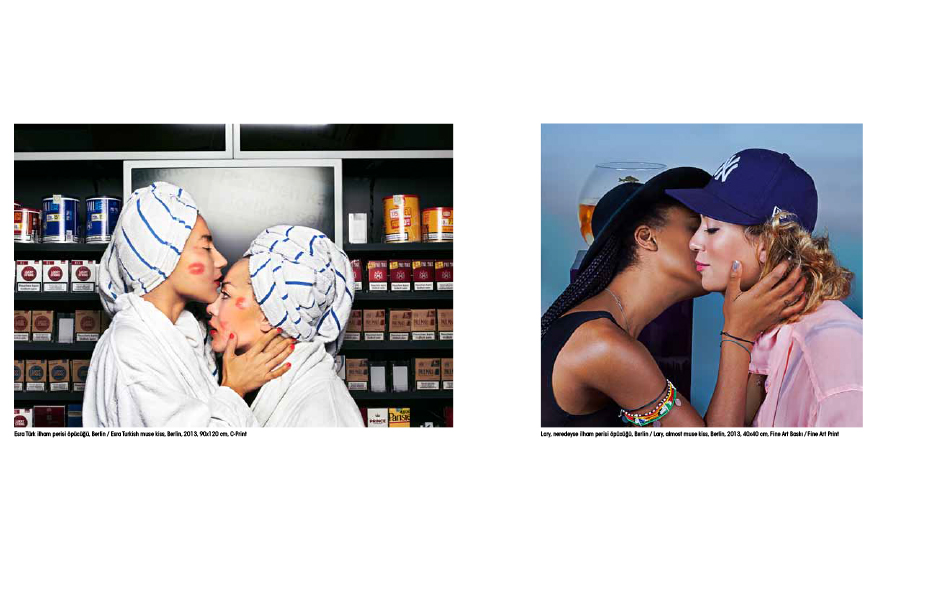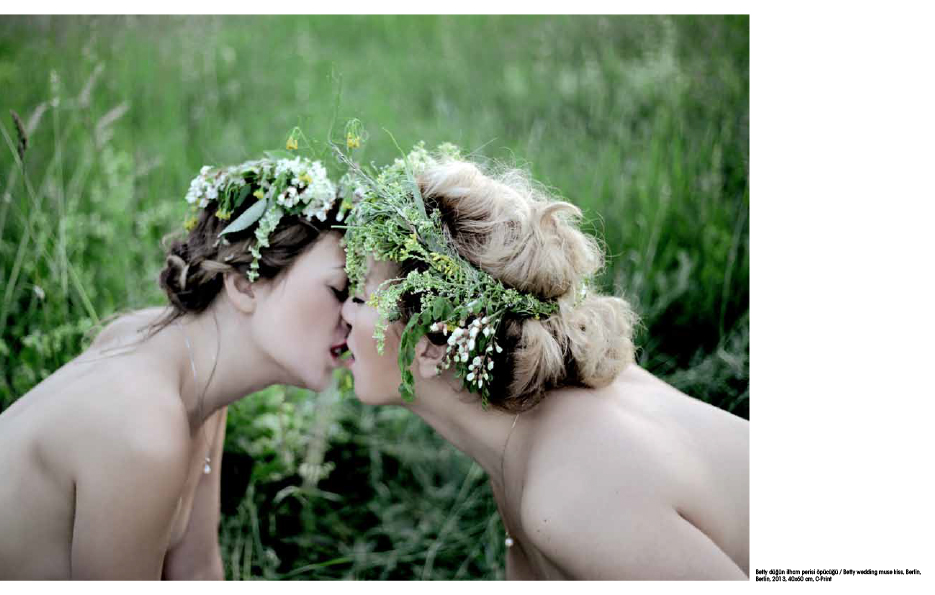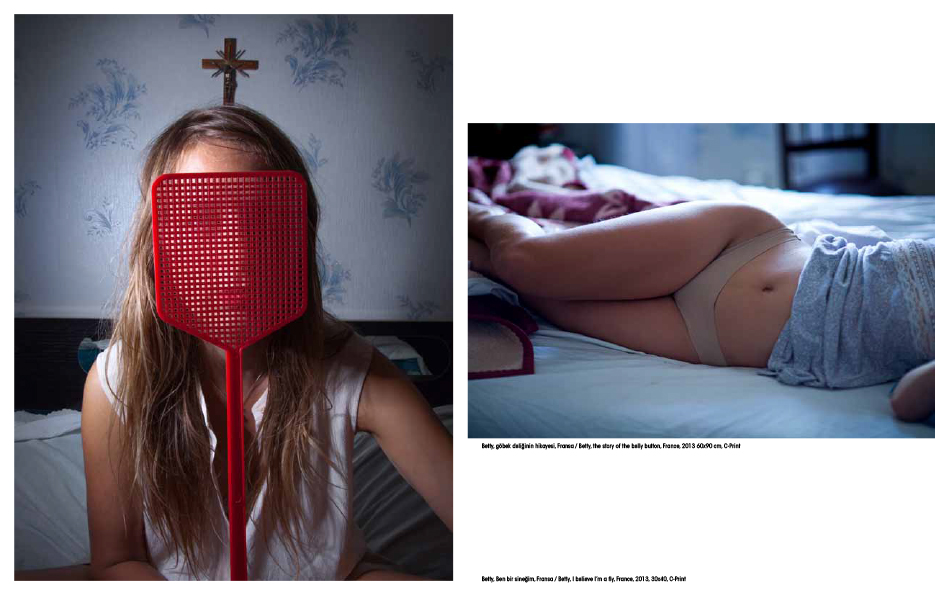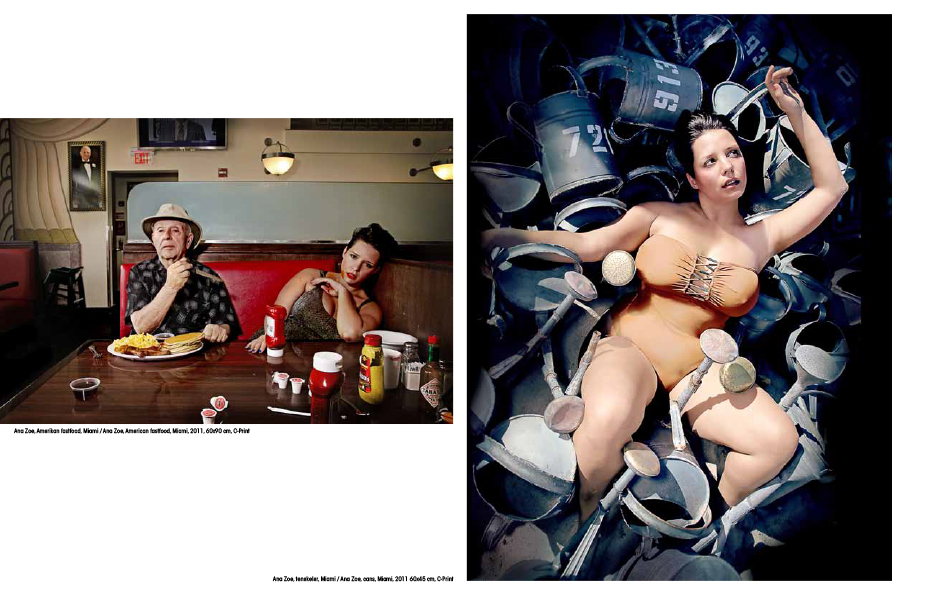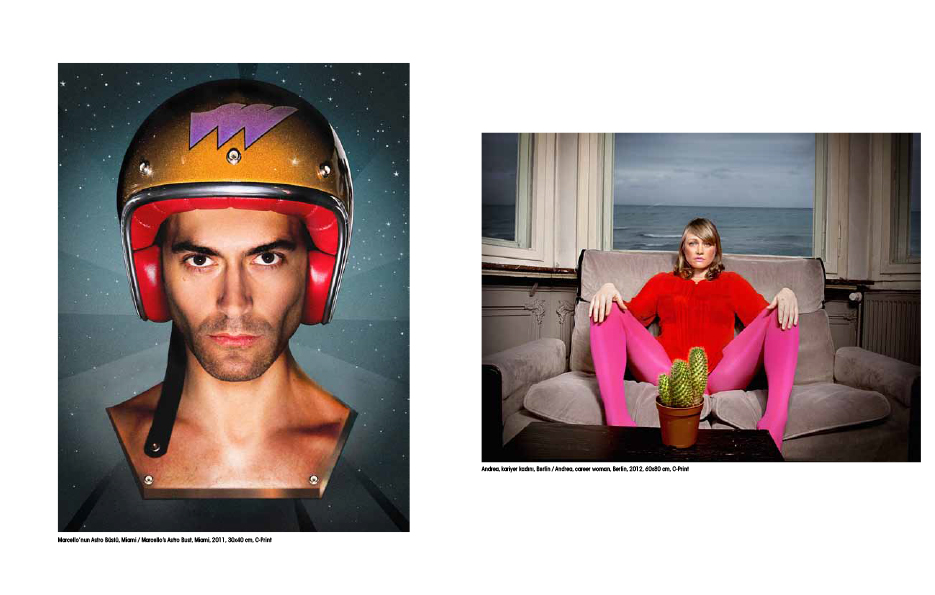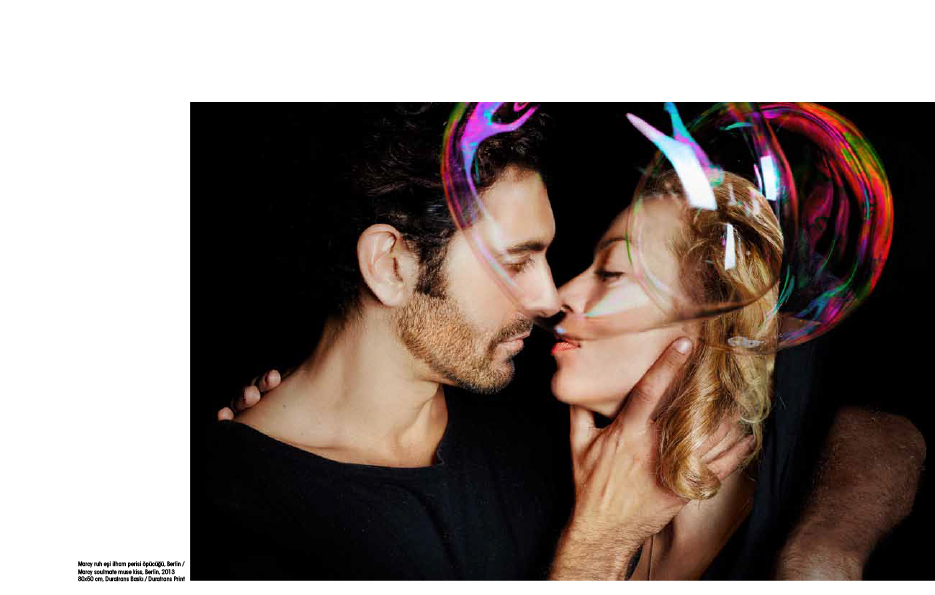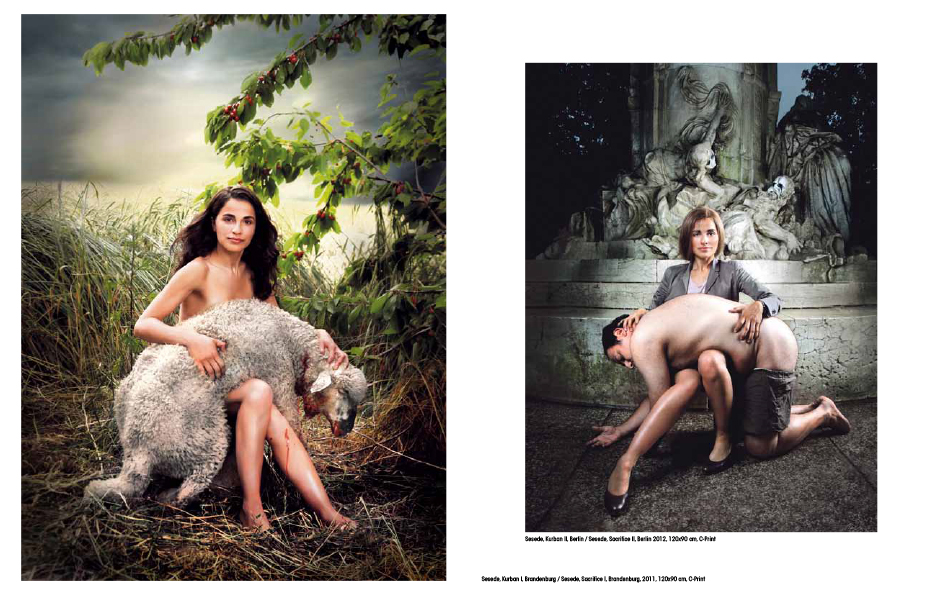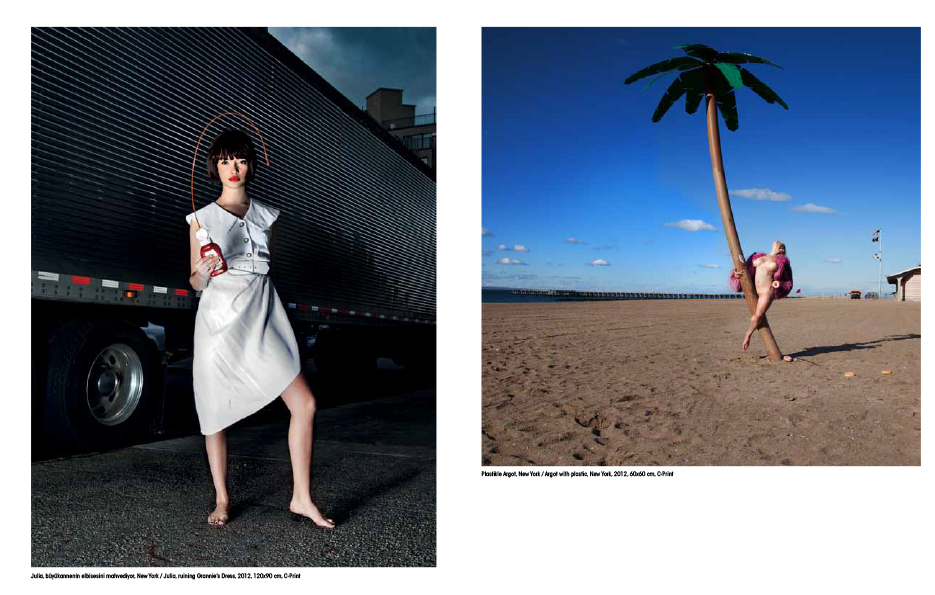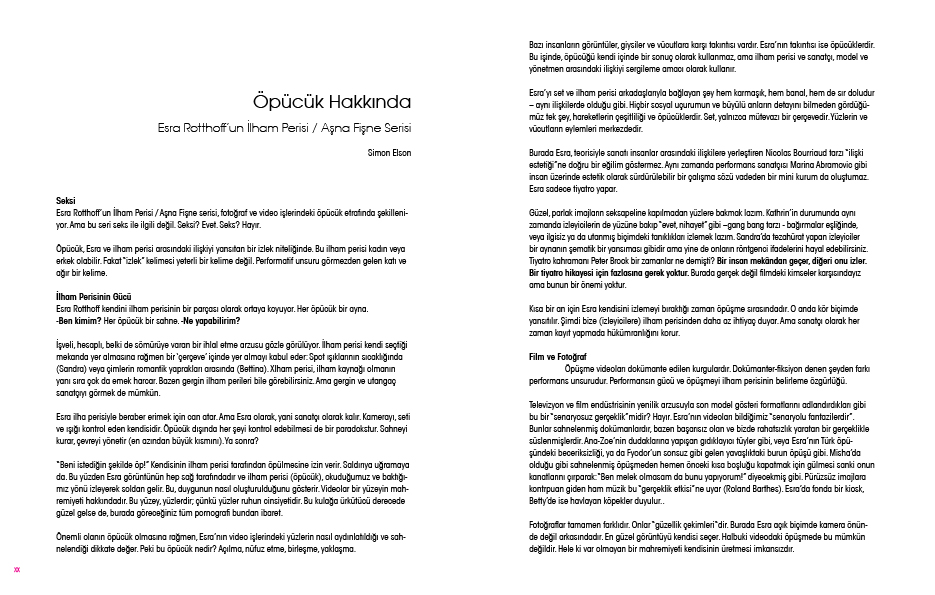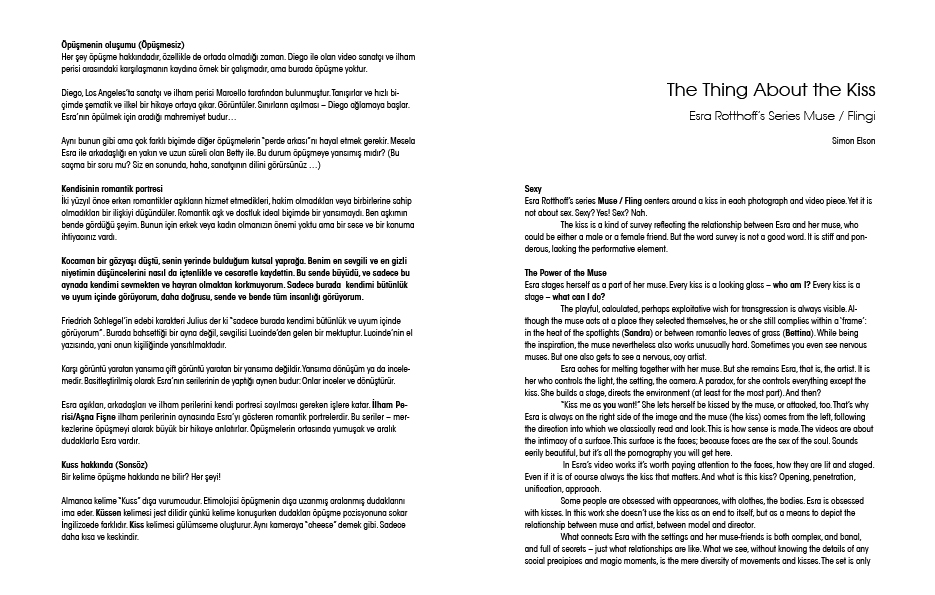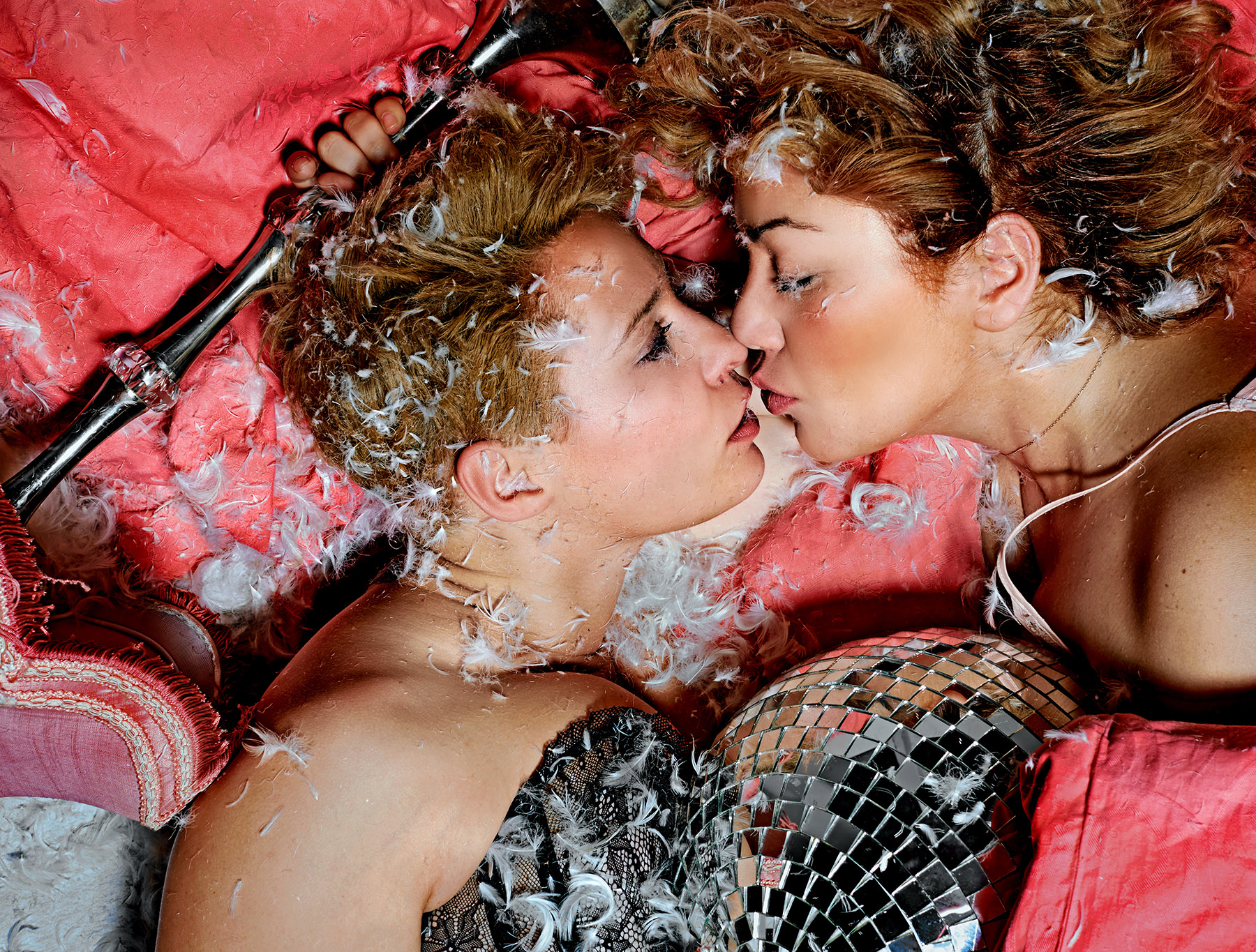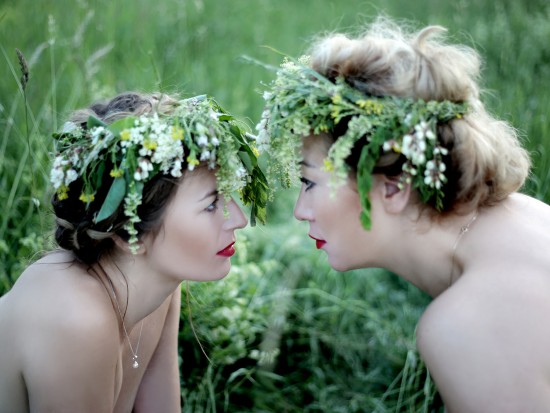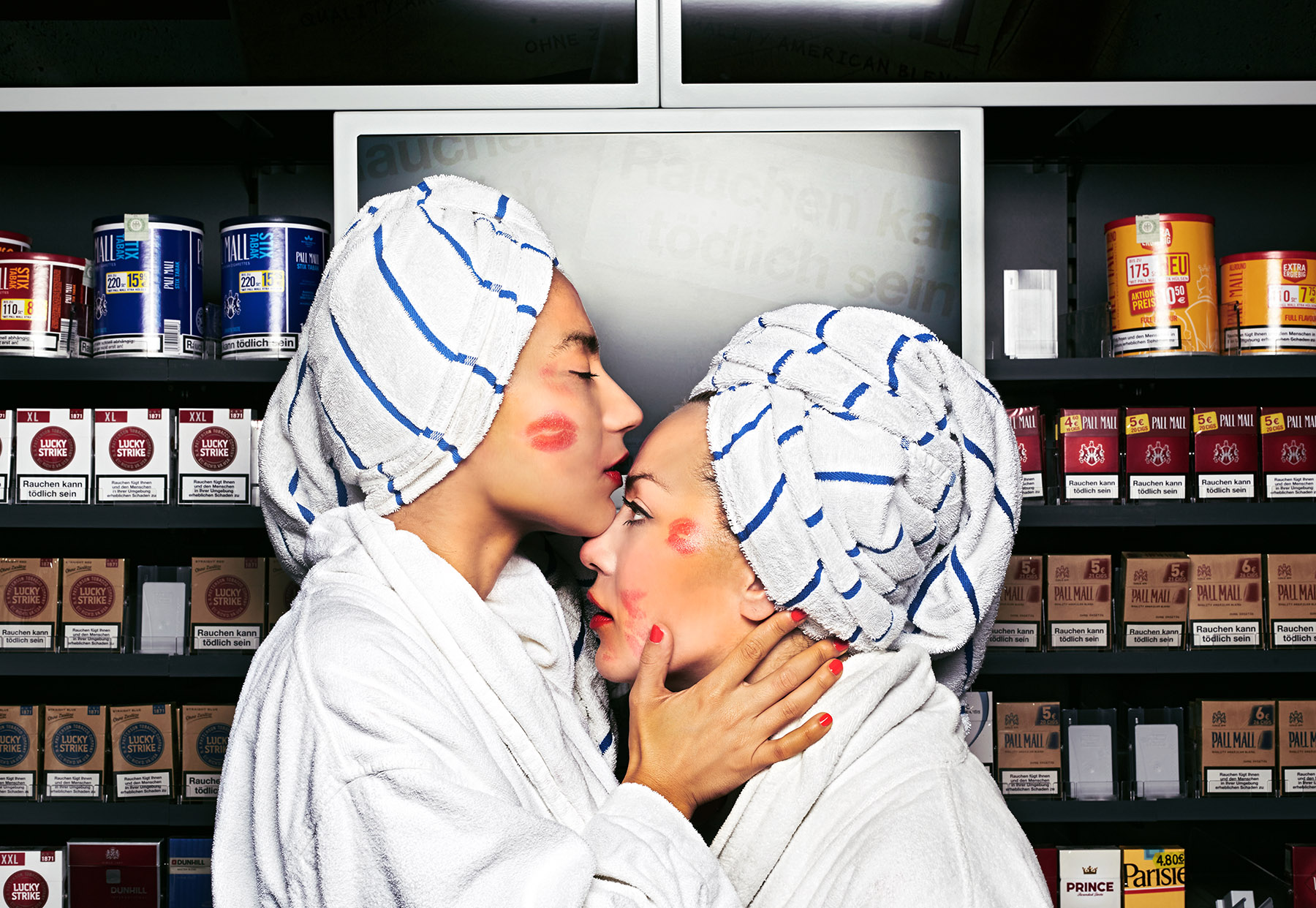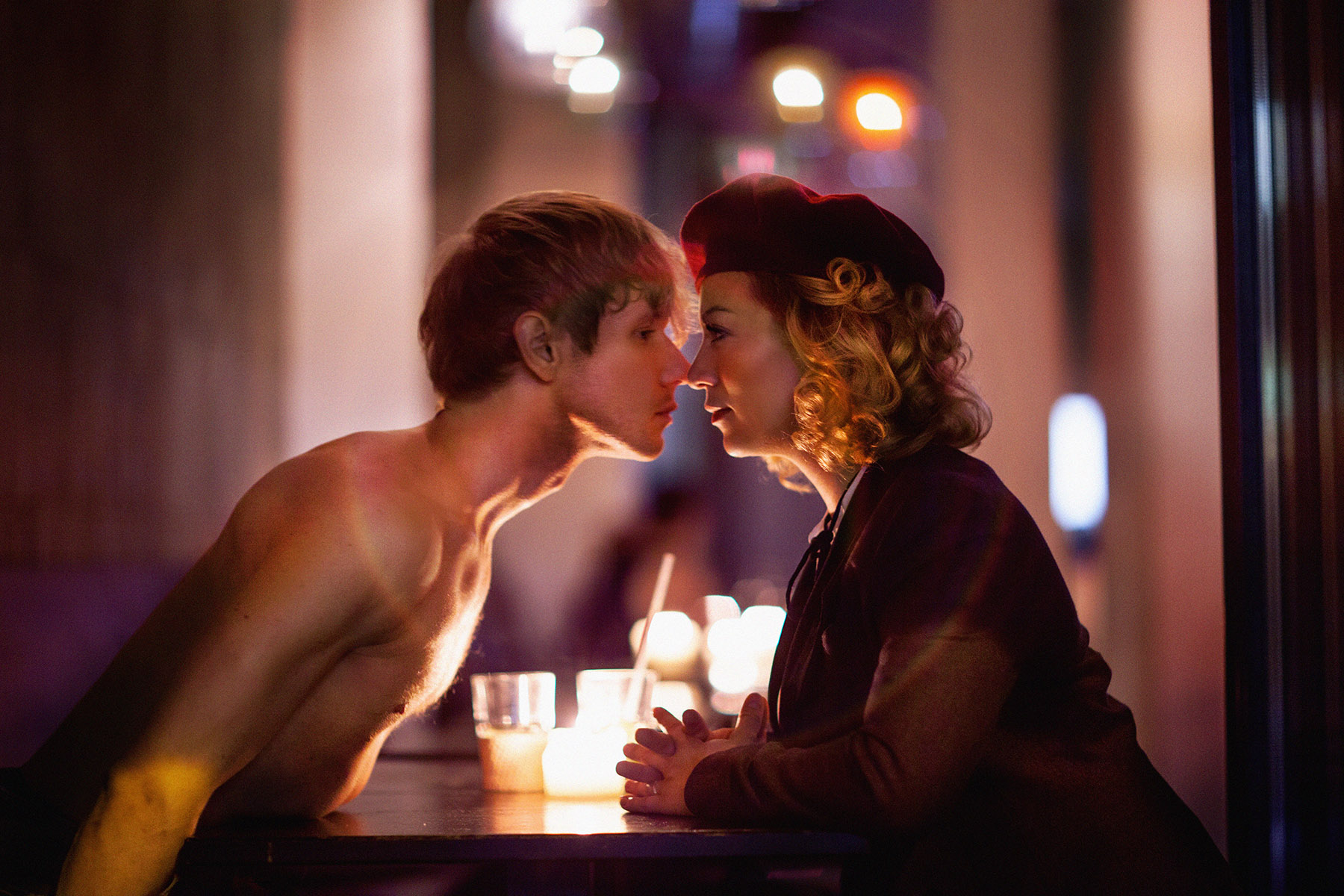ABOUT THE EXHIBIT
Muse/Fling: An Exploration of Relation and Inspiration
Relation: verb. 1) to tell; to give an account of. 2) to bring into or establish association, connection, relation. 3) to establish a social or sympathetic relationship with a person or thing.
Inspiration: verb, from Latin in+spirare. 1) to breathe in. 2) to fill with an influence. 3) to produce or arouse (a feeling, thought, etc).
In the photo+video series Muse/Fling, Esra Rotthoff documents personal relationships, their trajectory, and their physical manifestations through a simple but achingly profound gesture: The Kiss.
Esra invited a selection of her muses from past and present to participate with her in the Muse/Fling project. For each of the nine muses, she chose a setting connected to their shared life experiences. This space was very important, as this was the only staged aspect of the work; the action that occurred was entirely unplanned and spontaneous.
To each muse, Esra gave only one line of direction: "Kiss me. However you want!" She asked each person to not give her any clue of how they would kiss her. In this way, Esra - as artist - directed performative and aesthetic aspects of the interaction. Yet all the rest she - as human being - had to receive and experience as a surprise; the still photos capture individual moments of the experience, while the video captures the evolution of those moments. The project became all about exploring how much one could open up; how and how much one could receive.
Esra melts together with her muse in a game of documentation and staging: reflecting, examining, transforming their real-life relation and inspiration. What she can no longer control comes to the forefront; it is the main event, the thing itself. The Kiss.
Criticism/Reception:
"Muse/Fling affords the opportunity to see previous exchanges between the creator and inspiration, taking the audience along on the ride to peer through a key hole at the different facets, faces, and transitions of her subjects. There is an engaging contrast inherently present throughout Rotthoff's photographs, covered in a disarming, shiny, magazine-style package, allowing the casual viewer to be subverted covertly. Yet the anonymous air that this style imposes in advertising is here used as a hook where the true character of the subject shines through. For Rotthoff, “The Muse” - regardless of gender/orientation - is not just a pretty face to be objectified. There must be a natural personal resonance for her to be engaged, a shared history or past, physical or intellectual stimulation leading to enlightenment, and a irresistible urge to be connected in the future; an essential list of components that all the subjects share akin to a checklist of must haves."
-Kerimcan Güleryüz, Istanbul Gallerist
"Is war or love the origin of everything? In a city like Istanbul where change is imposed, and civil dialogue forced into protest, Berlin artist Esra Rotthoff dissects the creative process behind her iconic images, bringing to the center of the riots the provocative power of naivety, staging in striking videos and photos the fling for her muses. Hate or love Esra's method, she's going to teach you how to kiss."
-Marcello Pisu, Curator and Cultural Producer
"In Esra’s video works it’s worth paying attention to the faces, how they are lit and staged. Even if it is of course always the kiss that matters. And what is this kiss? Opening, penetration, unification, approach.... What connects Esra with the settings and her muse-friends is both complex, and banal, and full of secrets – just what relationships are like. What we see, without knowing the details of any social precipices and magic moments, is the mere diversity of movements and kisses. The set is only a modest frame. How the faces and bodies act are in the center. Here, Esra does not tend towards a 'relational aesthetics' à la Nicolas Bourriaud, whose theory displaces art into human interrelations. She also does not establish a mini-institute in the style of performance artist Marina Abramovic, promising a kind of aesthetically sustainable work on the human. Esra simply does theater."
-Simon Elson, Artist and Author
https://www.youtube.com/watch?v=5TXjT3JH_qI
THE THING ABOUT THE KISS
by Simon Elson
Sexy
Esra Rotthoff’s series Muse / Fling centers around a kiss in each photograph and video piece. Yet it is not about sex. Sexy? Yes! Sex? Nah.
The kiss is a kind of survey reflecting the relationship between Esra and her muse, who could be either a male or a female friend. But the word survey is not a good word. It is stiff and ponderous, lacking the performative element.
The Power of the Muse
Esra stages herself as a part of her muse. Every kiss is a looking glass – who am I? Every kiss is a stage – what can I do?
The playful, calculated, perhaps exploitative wish for transgression is always visible. Although the muse acts at a place they selected themselves, he or she still complies within a ‘frame’: in the heat of the spotlights (Sandra) or between romantic leaves of grass (Bettina). While being the inspiration, the muse nevertheless also works unusually hard. Sometimes you even see nervous muses. But one also gets to see a nervous, coy artist.
Esra aches for melting together with her muse. But she remains Esra, that is, the artist. It is her who controls the light, the setting, the camera. A paradox, for she controls everything except the kiss. She builds a stage, directs the environment (at least for the most part). And then?
“Kiss me as you want!” She lets herself be kissed by the muse. Or attacked, too. That’s why Esra is always on the right side of the image and the muse (the kiss) comes from the left, following the direction into which we classically read and look. This is how sense is made. The videos are about the intimacy of a surface. This surface is the faces; because faces are the sex of the soul. Sounds eerily beautiful, but it’s all the pornography you will get here.
In Esra’s video works it’s worth paying attention to the faces, how they are lit and staged. Even if it is of course always the kiss that matters. And what is this kiss? Opening, penetration, unification, approach.
Some people are obsessed with appearances, with clothes, the bodies. Esra is obsessed with kisses. In this work she doesn’t use the kiss as an end to itself, but as a means to depict the relationship between muse and artist, between model and director.
What connects Esra with the settings and her muse-friends is both complex, and banal, and full of secrets – just what relationships are like. What we see, without knowing the details of any social precipices and magic moments, is the mere diversity of movements and kisses. The set is only a modest frame. How the faces and bodies act are in the center. Here, Esra does not tend towards a “relational aesthetics” à la Nicolas Bourriaud whose theory displaces art into human interrelations. She also does not establish a mini-institute in the style of performance artist Marina Abramovic, promising a kind of aesthetically sustainable work on the human. Esra simply does theater.
One mustn’t get too seduced by the sexiness and the beautiful, poppy images. You have to look into the faces; in Kathrin’s case you should also look at the faces of the audience, witnessing the scene with shouts of “yes, finally” – gang-bang style – or disinterested, or with embarrassment. In Sandra one sees the cheering audience only as schematic reflections in a mirror, yet you can imagine their voyeuristic expressions. What did theater hero Peter Brook once again say? One person goes through the space, another watches it. More is not needed for a plot in theater. It hardly makes any difference that here we are only dealing with filmed bodies, no “real” ones.
For a short instance Esra ceases to watch herself: that is during the kiss. In this moment she is being mirrored blindly. Now she needs less us (the audience) than the muse. However, as the artist she always maintains the sovereignty over the recording.
Film and Photography
The kiss videos are documentary stagings. What distinguishes them from so-called documentary fiction is the performative element, the performative power and the freedom of the muse to determine the kiss him or herself.
Is this “unscripted reality” as the film and TV industry has called their latest show-formats in an urge for innovation? No. Esra’s videos are good old “scripted fantasies”. They are staged documents, sometimes embellished with reality, a reality that fails or leaves us with a feeling of unease – as in case of the “giggly” feathers sticking on the lips with Ana-Zoe, or Esra’s awkwardness during her “Turkish” kisses, or the endlessly slow nose-kiss by Fyodor. Or with Misha, where you can notice how the short emptiness just before the staged kiss is bridged with a laugh, just as if Misha would flap his wings and say: “Even though I am not an angel I will still do this!” The raw soundtrack which acts as a counterpoint to the smooth images fits to this “reality effect” (Roland Barthes). In Esra for instance you can hear a kiosk in the background, in Betty some barking dogs.
The photographs are completely different. The photographs are “beauty shots”. Here Esra is clearly no longer in front of the camera, but behind it. She selects the most beautiful image. With the kiss in the video that’s not possible.
The making-of a kiss (without the kiss)
It is always about the kiss, especially when it is missing.
The video with Diego is the exemplary record of an encounter between artist and muse, or artist and artist, at which end, however, there is no kiss.
Diego is a singer and was picked up by Esra and her fellow muse Marcello in Los Angeles. They meet. Quickly, a schematic and rudimentary story develops. Images. Transgression – Diego breaks down in tears. That’s the kind of intimacy Esra is looking to be kissed with …
Just like this, and then again in a completely different way, one has to imagine the ”behind the scenes” of the other kisses. For instance with Betty, whose friendship with Esra is the longest and closest. Is this reflected in the kiss? (Is this a stupid question? You do ultimately, haha, get to see the artist’s tongue …)
Romantic self-portraits
Around two hundred years ago the early romanticists established the concept of a relationship, in which lovers do not (necessarily) serve, dominate or “own” each other. Romantic love and friendship, ideally, is reflection. I am what I am because my lover sees it in me. For this you need a voice and a position, nevermind whether you are a male or a female.
A large tear drops onto the sacred leaf, which I found in your stead. How faithfully and simply did you record the audacious thoughts of my dearest and most secret intention. In you it grew and only in this mirror I am not afraid to adore and love myself. Only here do I see myself as whole and in harmony, or rather, the entire humankind in me and in you.
When Friedrich Schlegel’s literary figure Julius says “Only here do I see myself as whole and in harmony” he does not refer to an actual mirror but to the letter from his love Lucinde. He is reflected in handwriting, and therefore in Lucinde’s personality.
The reflection that produces a counter-image is not a doubling reflection. Reflection is a transformation or an examination. And that is, oversimplified, exactly what Esra’s series does: it examines and transforms.
Esra includes lovers, friends and muses into works that must be considered self-portraits. Muse / Fling is a romantic self-portrait presenting Esra in the mirror of her muses. The series tells a big story – with the kiss at its center. In the center of the kiss, so to speak with softly parted lips, sits Esra.
Thing with the Kuss (Postskriptum)
What does a word know about kissing? Everything!
The German word “Kuss” is expressive. Its etymology suggests that it emulates the pointed, roundly parted lips of kissing. The word Küssen is gestural language because the word interrupts one’s speech to form the lips into a kiss. In English this is different; the word “kiss” is a smile. Kind of like when you say “cheese” into the camera, only shorter, sharper.
Translated from the German by Anna-Sophie Springer
CATALOUGE
